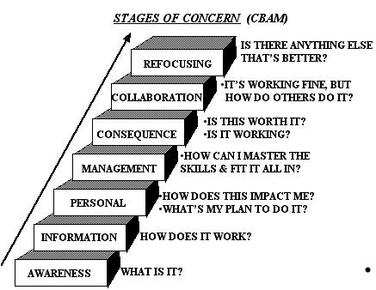|
For this assignment, I decided to work with two teachers at my current school. They are both intermediate teachers who teach grade 6. I also sought the advice from my teaching partner and library tech, who have both been at the school for a long time and know the kids and community. After discussing what the teachers and students needs are with my colleagues we decided to focus on digital resources. Teacher A is a Grade 6 teacher who has shifted her pedagogy with incorporating technology and research skills. For the past three years, she has collaborated with the teacher-librarian regularly and has seen improved results with her students. She takes the time to incorporate both print and digital resource search skills. “I want the students to take ownership of of their learning. I usually do a demonstration on how to do research and what search engines or database to use. From there, the students are able to explore and carry out their inquiry.” She is very flexible, collaborative and is eager to try new things with her class. Teacher A has 7 years teaching experience. Teacher B is a Grade 6 teacher who is not comfortable using technology. He lacks the knowledge to navigate through the digital reference resources on our school’s website. He has never brought his class to the library to work collaboratively with the teacher-librarian. He uses the library for book exchanges only and even then doesn’t always show up. When his students use the lab for a simple research assignment, he allows them to Google search the topics or whichever search engine they are comfortable using. Teacher B has 20 years teaching experience. 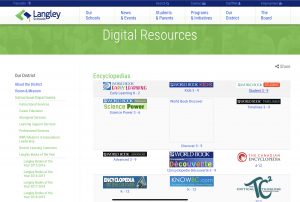 Digital Resources provided by Langley School District: https://www.sd35.bc.ca/our-district/instructional-departments/digital-resources/ After a brief discussion with my staff regarding the school library and the digital reference subscription package, I decided to focus on World Book Online. Out of 8 divisions that I see regularly (I work one day a week at this school), only one teacher used World Book Online regularly. I wanted to promote the digital reference package especially since many teachers have been discussing inquiry-based projects. While working in an middle school setting, World Book Online offers students a basic reference experience. They are able to (safely) search for topics of interest with authentic research and notable authors. It should also be noted that the school has a low literacy level, with may students being ELL and high needs. World book online is a great resource for my school because the information is easy to read and navigate. Furthermore, when resources are online students can easily translate the information. I would like to see the whole school use this reference service on a regular basis instead of letting these resources collect digital dust, lost on the web. If students (and teachers) are not using these resources, or are just unaware how to use them, I feel like I am not doing my job!
Teacher A (CBAM)
Stages of Concern:Collaborative, RefocusingCollaborative Teacher A has invested to work collaboratively with the teacher-librarian for the past 3 years. She values personalized learning and is currently working on a ‘Genius Hour’ project with her Grade 3 students. Because she values the importance of collaboration and inquiry, Teacher A is my school’s lead teacher for the upcoming “New Curriculum” professional development day. Teacher A is constantly using World Book Online. She teaches her class that this is for the first site to begin with research.Refocusing Teacher A shares her students’ successes during staff meeting and is constantly reevaluating her teaching style. Grade 3 students are enjoying the independence and researching an area that interests them. ‘Genius Hour’ is in its third week. Soon, once students have finished with the initial research, they will be creating a Google Slide to showcase their findings. Not only must they include relative information, each student can find suitable images, charts and video and enhance their work.My Assessment: Typical Expressions of Concern: Refocusing Levels of Use of the Innovation: Renewal Teacher A (SAMR Model)
Teacher A enjoys using technology especially anything involving Google Apps for Education. She uses Google Slides, once the initial research from World Book Online is complete. Level: Augmentation Google Slides is the main platform for students to showcase their work. Teacher A uses the ‘shared’ and ‘comment’ options to constantly give feedback and for students to share their work with others for peer review. Students are able to type their research findings and locate suitable pictures for each slide. Level: Modification Students are able to search for suitable video or sound clips to enhance their presentation. With Grade 6 students, they enjoy changing the slide and font colour and adding transitions. Though this may be basic it gives the kids ownership of their work. Sometimes they need to be reminded not to spent too much time on this. They must select appropriate colours and give credit for any photos or info they find.Teacher A provides criteria on how each presentation must look, how many sources they have to use and what the presentation must include. 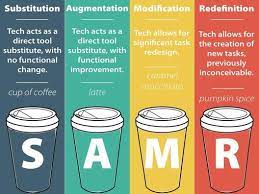 SAMR Model image retrieved from: https://www.schrockguide.net/samr.html Teacher B (CBAM)
Stage of Concern: Awareness, Informational, Personal, Management: Awareness Teacher B has never utilized World Book Online with his teaching. He prefers to use print copies of books only. This is a problem considering our reference section is mostly gone digital and the books that remain tend to be 15 years old or more. He does not like inquiry learning but is aware of its importance with the new curriculum. Teacher B has never used the district’s digital subscription package. Even when the school district and myself promoted all of our wonderful digital resources and did a few demonstrations with the kids on how to access and use the sources he was still reluctant. he claimed that kids need to use print sources instead because their was “ too much bad information on the internet”. Informational Since having four discussions regarding World Book Online, Teacher B has started to shift his beliefs. I kept the dialogue going and showed how using the resources like World book, set forth by the district, students are in a secure web browser and considered safe4. I also, had to drive the concept home that digital is the way of the future, as our library no longer purchases things like encyclopedias and other expensive reference resources, instead turning to free or cheaper, and up to date, digital resources found on the web, and provided by the district. He would like to work with me and “try out” inquiry with his students. Teacher B requested more demonstrations during our time together to teach him and the students how to navigate World Book Online. i am looking into recording “how to” videos to post on our library’ s blog so other teachers and students can use these when they need a refresher or if they missed a demo. Currently, Teacher B and his class have had two sessions with myself and I can see their confidence growing . The class is working on researching different systems of government. Personal I’ve asked Teacher B to brainstorm some ways He could see himself using World Book Online either personally or with students. Also, I’ve tasked him to give me a demonstration on how to use the site. He was worried that he would make too many mistakes. I stated that making mistakes is part of the learning process and growth mindset (something the whole school works on). To strengthen the positives of World Book Online, I asked Teacher B to watch how I used the site and to view how my students (in Grade 7) have mastered searching for a topic.Management I want my colleague to reflect on this process and to share whether he sees himself using World Book Online for other subjects. What are his frustrations, concerns or questions? He still feels overwhelmed using tech and digital resources with students but is willing to give the reference site a try. My Assessment Typical Expressions of Concern about an Innovation: Management Level of Use of the Innovation: Preparation 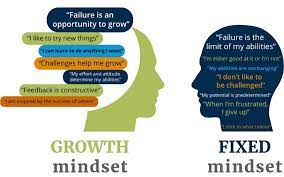 Growth mindset image from: https://ceoworld.biz/2020/12/15/cultivate-a-growth-mindset-for-a-prosperous-new-year/ Conclusion
There are many obstacles to change how two of my colleagues feel about using the library. The most difficult obstacle for myself is time. I am only there on Fridays, which often falls on holidays and Pro D days. Although, it is difficult to change teacher’s habits and thinking sometimes, I like to remind myself that the ultimate goal of the library is to improve student achievement through the refining of instruction for essential literacy, research and inquiry (Canadian Library Association, p. 13). We know that many teacher’s are creatures of habits. Often relying on what they may have been taught decades ago and not liking change. This, according to Bloom’s Taxonomy, is the lowest level of thinking (Comprehension). The education field is constantly changing, maybe even more so with technology. This constant change may become overwhelming and futile for teachers to even keep up with. I see this when some teachers are reluctant to adopt new ways of teaching and incorporating tech and digital resources. Many think that young students already receive too much screen time at home. However, teacher-librarians must take the role as a educational leader, both in literacy and technology, and promote new teaching strategies. True, teaching research skills and promoting literacy is at the forefront for a teacher-librarian, but supporting staff and providing professional development in areas of resource usage is important work as well. As SD35’s Instruction Role of the Teacher Librarian States:
“The teacher-librarian is an active participant in the educational community. Within the Library Learning
Commons where the goal is increased student success, the teacher-librarian is a key instructional specialist who promotes reading, inquiry, and the effective use of resources. The TL is expert at balancing: Learning Design, Curriculum, Assessment and Collaboration ,Literacy and Multiple Literacies ,Technology Integration ,Management: Time, Budget, ,Facilities, Resources and Tools.” 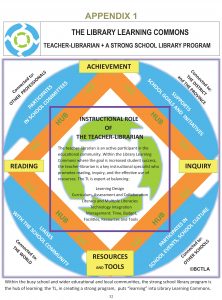 Image and quote retrieved from: https://instructionalservices.sd35.bc.ca/curriculum/learning-commons/
I think that this role is very complex but appreciate the simple definition. I think it is very beneficial to have this clearly defined not only for myself so I can understand my job but also for my staff and students. I also think that change takes time. Building relationships with my staff and students is so crucial, if I wish to change the way they access information, work together and how they view/use the library. I plan on staying positive, building relationships and collaborating any chance I get! References Canadian Library Association (2014). Leading Learning: Standards of Practice for School Library Learning Commons in Canada. Retrieved from http://clatoolbox.ca/casl/slic/llsop.pdf. Cure, D. L. (2020, December 15). Cultivate a growth mindset for a prosperous New Year. CEOWORLD magazine. Retrieved March 7, 2022, from https://ceoworld.biz/2020/12/15/cultivate-a-growth-mindset-for-a-prosperous-new-year/ Digital Resources. Langley School District – School District #35. (n.d.). Retrieved March 5, 2022, from https://www.sd35.bc.ca/our-district/instructional-departments/digital-resources/ Huang, P-S. (n.d.). Concerns-Based Adoption Model. Retrieved from https://sites.google.com/site/ch7cbam/home/levels-of-use. Instructionalservices.sd35.bc.ca. (n.d.). Retrieved March 9, 2022, from https://instructionalservices.sd35.bc.ca/wp-content/uploads/sites/76/2017/05/In-the-Loop-June-5.docx National Academy of Science (2005). The Concerns-_Based Adoption Model (CBAM): A Model for Change in Individuals. Retrieved from http://www.nationalacademies.org/rise/backg4a.htm. SAMR. Kathy Schrock’s Guide to Everything. (n.d.). Retrieved March 7, 2022, from https://www.schrockguide.net/samr.html |
Tag Archives: #Teaching Practice
LIBE 467 Assignment 2: Collaborate with a Teacher and Evolve their Practice
Filed under Class Assignments, Uncategorized

